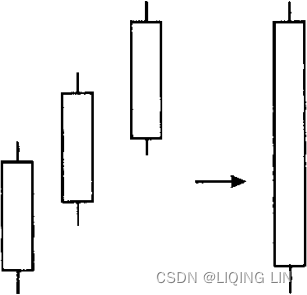Three White Soldiers

 The Three White Soldiers pattern reduces to a very bullish long white candle line. This breakdown is in full support of the pattern, which makes confirmation unnecessary.
The Three White Soldiers pattern reduces to a very bullish long white candle line. This breakdown is in full support of the pattern, which makes confirmation unnecessary.
Behavior and Rank
- Theoretical: Bullish reversal.
- Actual bull market: Bullish reversal 82% of the time (ranking 3).
- Actual bear market: Bullish reversal 84% of the time (ranking 3).
- Frequency: 67th out of 103.
- Overall performance









 订阅专栏 解锁全文
订阅专栏 解锁全文















 2503
2503











 被折叠的 条评论
为什么被折叠?
被折叠的 条评论
为什么被折叠?








